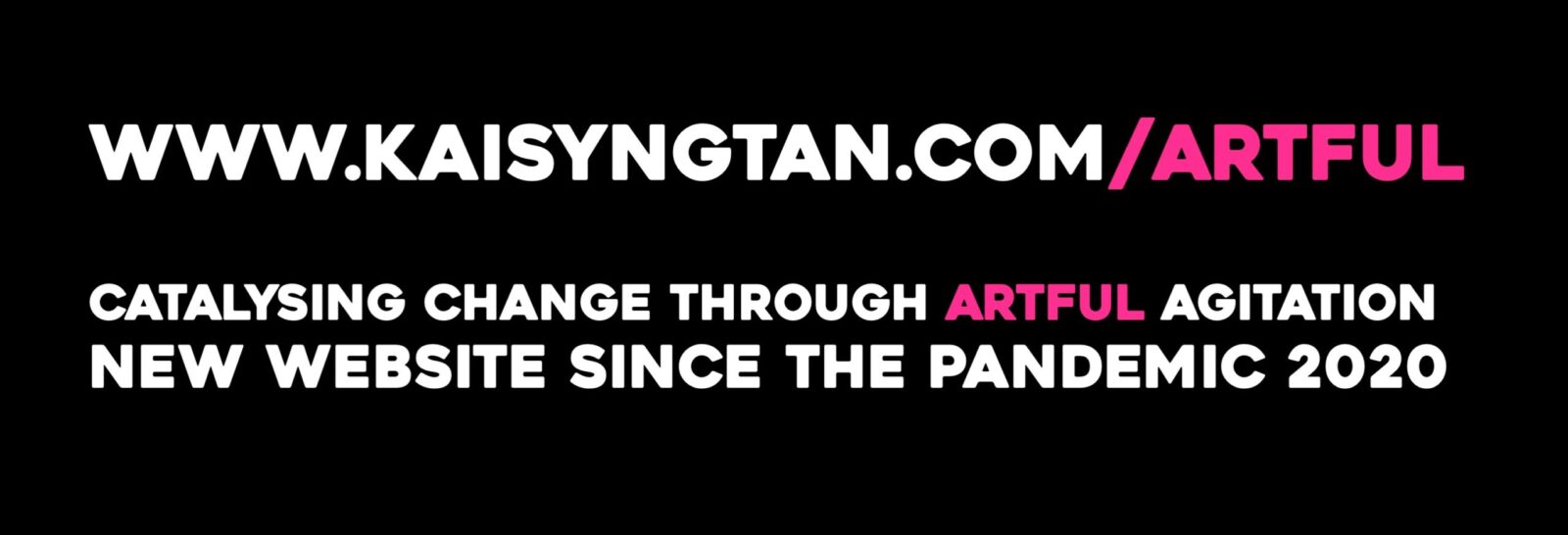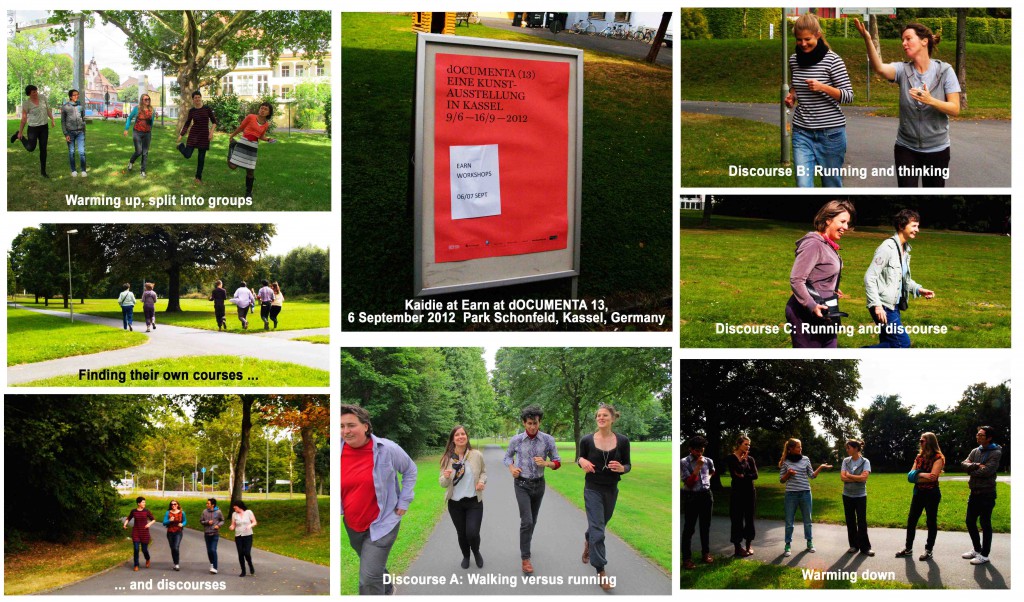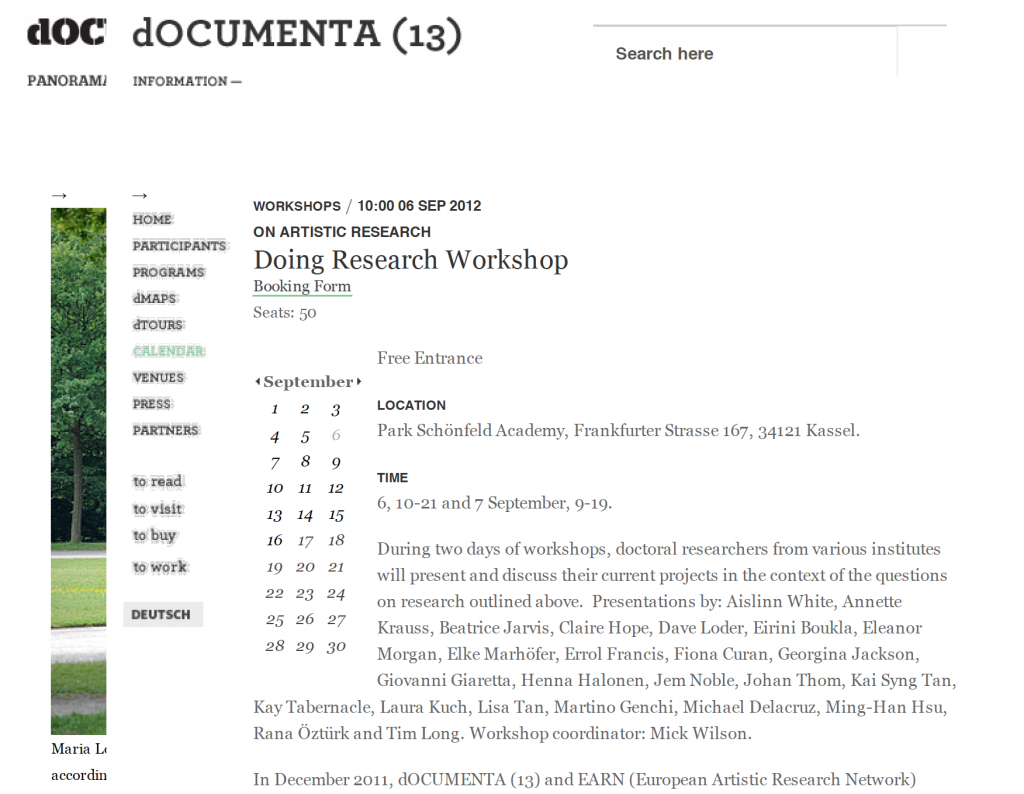Can running activate a discourse? Come think on your feet – and join RUN! RUN! RUN! on a Running-Discourse, in which we walk or rather run out of the ivory tower, to get our hands – and feet – dirty, to walk the talk, or rather, run the talk, while running and talking, about running, talking and, by extension, thinking and discourse. The Running-Discourse first debuted at dOCUMENTA 13 in Kassel, Germany (September 2012). Variations of the interactive performance have subsequently been seen at Synthesize2014 at Lancaster University (September 2014) and South East Asian Arts Festival in London (October 2014).
[ppmaccordion]
[ppmtoggle title=”What is a Running-Discourse?”]
The central proposition of the RUN! RUN! RUN! International Body for Research is that we can use running as a playful app or toolkit to help us re-imagine the way we do things or think. The Running-Discourse is a format to disseminate this proposition.
At the same time, a Running-Discourse is also mechanism to carry out field work to test out a theoretical speculation. The speculation is that running can activate thinking.
A rundown of a Running-Discourse is as follows: A RUN! RUN! RUN! facilitator splits participants into groups. Each group is given a question to work on. Participants go off on a run with group members, and while running, discuss the given question. Participants are asked to pay particular attention to their own processes of running and talking. After the time runs out, participants gather together to share their findings. At the end of the session, facilitator reveals that they have been a foot messenger or ambassador of running. [/ppmtoggle][ppmtoggle title=”Knowledge exchange; knowledge creation; kinaesthetic learning”]
The potential contributions or provisional messages of the Running-Discourse are as follow:
In the area of running and how we understand it:
- Running could be activated as a creative toolkit to help us think about different modes of thinking that we may engage in while we are in motion, or while we are running.
- By running a discourse while running, we could find out for ourselves if running is or isn’t conducive to discourses. Perhaps there are a range of factors. Perhaps it is subjective.
- If running could indeed be conducive to discourse, then it could give cultural tradition of walking a run for its money. Walking, rather than running, has traditionally been credited as being conducive for thinking (think Benjamin, Wordsworth et al).
In the areas of collaboration and research:
- The Running-Discourse may function as a playful intervention to traditional or dominant approaches of knowledge production. It may also contribute to existing discourses about the possibilities of artistic research and discourse, (including the the not-knowing and the intuitive), as well as non-logocentric approaches to discourse.
- The Running-Discourse may act as a starting point for us to think about cross-disciplinary collaboration. Anyone from any disciplinary background can join in a Running-Discourse. Participants can talk about running from different perspectives, including medicine, paleoanthropology and so on, or from their own personal experiences. Could this also be a form of knowledge-exchange or even knowledge-creation, if participants make new ‘discoveries’ along the way?
- A Running-Discourse may also help us think about research. Could research also involve practice, making, doing, running, and embodying? Could research also be subjective, felt and sweaty, aside from being abstract, distant or objective? Could first-hand (or first-feet) knowledge be an important source of knowledge? (Further research can be conducted in the area of kinaesthetic learning).
[/ppmtoggle]
[ppmtoggle title=”What are the possible discussions?”]The questions are based on the theoretical speculations of the correlation between running and discourse. The central question underlying these probes are: ‘Is running related to discourse? Can running activate a discourses?’ Depending on the size of the group, there could be a different number of questions, or the same questions can be repeated amongst different groups. Needless to say, if there is appetite or stamina, discourses beyond these areas could also be explored. Sample questions could include:
Discourse 1: Walking versus running:
- From your experience and/or from what you are doing now (talking and thinking while running), how do you think walking and running are similar or different physically?
- How are they similar or different in terms of what goes through your mind?
Discourse 2: The correlation between movement and thinking:
- From your experience and/or from what you are doing now (talking and thinking while running), do you think differently when you are moving compared to when you are not moving?
- For instance, (how) do you think differently when you are walking, cycling or sitting in a train, compared to when you are standing in a shower, lying in bed, or sitting down (under a tree like Buddha or Newton?)?
Discourse 3: Discourse: running, talking and thinking:
- From your experience and/or from what you are doing now (talking and thinking while running), (how) do you think running activates or promotes talking and thinking?
- (How) do you think the running affect the quality of the discussion?
- How does this compare to when you are having a discussion in the classroom for instance, or when you are on a hiking trip?
- (How) are your discussions affected by what you encounter as you are running (scenery, traffic et al)? (How) do they distract or inspire you in your discussion?
[/ppmtoggle][ppmtoggle title=”What could the running time of the run be?”]
The duration of the run itself (excluding the briefing time and sharing session) could be anything from 2 minutes to 2 hours.
A short duration that comes with a promise that one’s mascara will not run out may persuade even the most hardcore sceptics to join in.
A longer run or running time may bring about a much better-drawn out discussion that may open things up, complicate things and provoke more further discussions in new directions; runners may even reap surprising rewards if the endorphins or endocannabinoids kick in.
Alternatively, it may exhaust inexperienced runners and/or exhaust the given discussion point.[/ppmtoggle]
[ppmtoggle title=”Running a discourse in English, Chinese and Latin”]
This section describes the theoretical underpinnings of a Running-Discourse. There are five disparate strands of thought. The intention behind a Running-Discourse is that it pulls together these different strands and bring them to life, and get tested out and affirmed or dispelled by participants. In other words, a Running-Discourse is a mechanism to carry out field work to test out a theoretical speculation.
- Encompassing ‘conversations, narratives, arguments, speeches’ (Blackburn 2008), a discourse is a ‘process of understanding, reasoning and thought’ (Harper 2001). In other words, discourse concerns thinking and talking; it is not static but is, instead, a reciprocal process, an exchange.
- The Chinese character ‘dao’ (‘tao’) consists of two radicals, that of the human head, and the motion verb of the feet and footprints (Keelan 1967, p.22). Dao, the root word for the ancient Chinese tradition of Daoism (Taoism), has a range of meanings, one of which is discourse (Hansen 1996). Rendering discourse as dao reinforces the notion of discourse as a synthesis of talking, thinking and movement. That is to say, talking, thinking and movement run hand in hand; without movement there is no discourse.
- But what could be the locomotion of the proverbial feet? Could running be the specific movement of the feet that activates a discourse? After all, the 16th century Latin etymology of ‘discourse’ is ‘discursus’, which refers to ‘running from one place to another’ (Blackburn 2008 p.102).
- Around the same time throughout Europe, foot messengers or ambassadors were sent around to deliver messages. This being the age before Twitter, Fedex, the Royal Mail or the steam train, the next best option was human steam. Walking would have been too slow. These foot messengers ran (Gotaas 2009, pp.9-22).
- Turning back to the English language and world, this time to the word ‘run’, indeed reveals an association between running and thinking. According to the Oxford English dictionary, the 14th century definition of ‘run’ refers to thoughts that ‘come suddenly into (or in), to course or pass through the mind’ (Simpson and Weiner 1989, vol. XVI, pp 252-259).
The Critical Run seems to be a successful example of a synthesis of running and debating. Conceived by Danish-French artist Thierry Geoffroy, this is a series of artworks in which people debate about art – while running (2012). Over the course of the 20-minute runs, topics discussed have included immigration, colonialism and the role of the artist in society. Geoffroy calls it ‘an art format for criticism’ that is ‘stimulating, debating and sweating’. The runs are ‘critical’ as the debates are ‘burning’ and have to be discussed ‘before it’s too late’, argues Geoffroy.
The Running-Discourse is inspired by Geoffroy’s work. It may be distinguished from Geoffroy’s in that as a format that is a self-reflexive un-packing of the physical and poetic processes of running itself, rather than only using running as a vehicle through which general topics are discussed.
[/ppmtoggle]
[/ppmaccordion]
Above: Images of the debut Running-Discourse interactive performance at dOCUMENTA 13, Kassel, Germany. Below: Context of the Running-Discourse, as seen on the dOCUMENTA website 2012.


